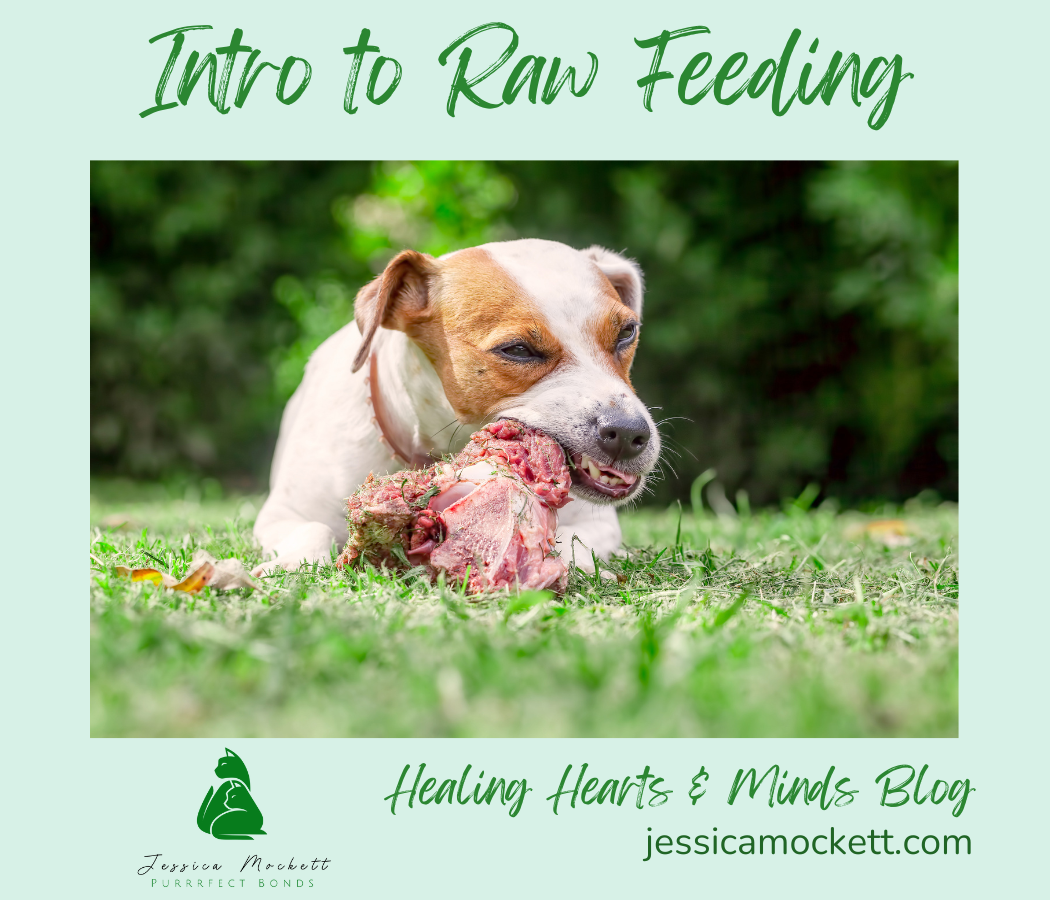This blog post provides a basic intro to raw feeding that every pet owner should know. We will go over terminology, transitioning onto raw foods, tips for raw feeding, and how to calculate calories needed to help kitty or doggie gain, maintain, or lose weight. Raw food is an important tool for many pets to achieve healthier lifestyles.
Vocab Terms for Raw Feeding
When it comes to raw feeding here are some basics to help you shop and find what is best and most cost effective.
BARF diets are raw protein diets that also incorporate some small percentage of veg, fruit, nuts, oils, herbs for dogs. Generally for dogs this diet is about 65-70 meat. Cats should have PMR raw diets and not BARF.
PMR diets are raw diets based on eating live prey. This is the 80/10/10 or 80/10/5/5 diets that are just muscle meat, bone, organs.
Whole prey is sometimes used with dogs, giving them thawed whole prey (ie quails, rabbits, or ducks) is mentally and emotionally (not just nutritionally) satisfying for bigger dogs. Large meaty bones can also work for this. Connect with a local butcher for things like knuckle bones, neck bones, etc that are not typically sold to humans. (this is an outside only feeding-time activity)
HPP stands for high pressure processing/pasteurizing. This is to reduce potential bad bacteria and preserve raw foods for longer. Some raw pet nutritionists feel this is best and some are avidly against it. My personal thoughts are if it isn’t necessary (like having an immune compromised pet) then choose products that haven’t undergone HPP.
AAFCO is the org that creates pet food standards for commercially produced foods. Association of American Feed Control Officials. They are important for creating general safety and nutrition standards, however, they are not the “end all” on quality pet nutrition. For instance, they don’t require Taurine in cat food which is an essential amino acid for cats because their bodies do not create it (it has to be added to highly processed foods because they rarely contain real meats and the intense high heats would kill the opportunity for and naturally occurring taurine). Omegas are not a pet food requirement. And they don’t require pet food labels to disclose carbohydrate percentages for dogs or cats who are respectively dominantly and obligately carnivores.
“Whole” or “Complete” Meals are terms frequently used by raw or freeze dried raw food companies when they are producing PMR or BARF raw, but they also add supplements to meet the AAFCO standards.
Tips for Raw Feeding
Keep it frozen until ready to use.
You can thaw in fridge to the point where the meat is soft enough to break up into smaller portions and then immediately refreeze the rest not to be used yet.
You can use things like ice cube trays with lids to divide up raw food portions for refreezing. Especially helpful for cats and smaller dogs who only need 1-3 ounces of raw per meal, or use these as a frozen raw food treat for a big dog. Pop them out of the tray frozen and then thaw in fridge in a shorter amount of time.
Keep everything frozen or refrigerated to reduce potential bacterial growth. Be sure to use thawed meats within 2-3 days of thawing.
Feed at least 2 meals a day for both cats and dogs. Some animals do best with 3-4 smaller meals in a day, especially kittens/puppies, seniors, or pets prone to vomiting after eating too quickly.
You do not have to do 100% raw if it is not affordable or not possible because of work schedules. Adding any amount of raw food to the diet will always give the animal nutritional benefits.
You can mix into the raw food things like bone broth (intended for dogs/cats), raw goat milk, freeze dried raw, fresh pasture raised eggs, kibble, wet food, and baby food meat flavors.
Keep the blood that drains from the meat and mix it back in when you serve it.
The less oxygen exposure the meat gets the better, as it will begin to turn brown (not stay red). I place plastic wrap around the meat inside a glass storage container in the refrigerator. There is likely a more sustainable option than this, so let me know when you find it!
Caloric Intake Calculations

In general, if your pet is healthy or already the ideal weight (a 5) on the 1-9 body condition score chart for either cats or dogs, you feed them 2-3% of their total body weight. If they are a puppy/kitten or underweight, same calculation is based on the ideal adult weight not their current weight. If they are overweight, you feed them 2% of their ideal body weight.
Now, for more exact calculations you can use one of the several pet calorie calculators online like this one to figure out total calories needed. The Resting Energy Requirements (RER) are for essentially a sedentary lifestyle. For Maintenance Energy Requirements (MER), this is for maintaining current weight for different activity levels.
You do not have to be exact every day but within a reasonable caloric range. So if the RER for the animal is 300kcals/day and they are not active, feeding between 275-325/day is usually acceptable. However, measuring calories exactly can be important to prevent obesity in our pets.
Also, treats, which are especially given to dogs, should never total more than 10% of the total day’s calories. So be sure to include treats in your daily calculations of food.
Transitioning to Raw Food
- We want to transition into raw feeding slowly.
- If you have a senior pet, a very ill pet, or highly sensitive pet, please be sure to consult a holistic vet prior to making big diet changes. Blood work may be needed before you start.
- Typically, it is easiest to transition kittens/puppies onto raw then mature animals who have been used to eating predominantly dry kibble, this is especial true for cats.
- Cats often take many months to fully transition, and dogs typically take several weeks.
- We do it slowly to 1) help reduce bowl reactions of diarrhea and other tummy upset 2) to adjust the animal to the new flavors/textures 3) to reduce any potential “flu-like” responses as the liver and kidneys detox and 4) to help you gauge any other changes or concerns with the animal’s reaction to the new food.
- Generally this is the pattern for slow transition:
¼ raw to ¾ regular wet food or kibble until easily accepted
½ raw to ½ regular wet food or kibble until easily accepted
¾ raw to ¼ regular wet food or kibble until easily accepted
100% raw moving forward
If you want to stop the transition at any point where the animal has accepted the change, because you do not plan to do 100% raw, than that is fine.
You may need to start out on 10-15% raw meat with really picky kitties.
- If kitty or doggy doesn’t like eating cold meat, you can add warm bone broth to bring it to room temp or you can add warmed raw goat’s milk for animals who like that. Or you can very lightly brown the meat on low heat. Remember that microwaves change the structure of the nutrition, you can use them for ease, but if you have time it’s best to warm milk, broth, and raw meat on the stove.
- Cats and dogs who miss kibble can do well with freeze dried meat crunchies that are not reconstituted with water. Just be sure that the animal is getting enough water in other meals and has attractive drinking stations.
If you are ready to try out raw food, I recommend Viva Raw for cats and smaller dogs (because of portion sizes). If you want to save 20% on your first order, use this link. (I get a discount on my next Viva order if you use the link.)
If you want to read more on the care of cats, check out my books!




